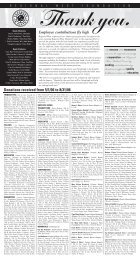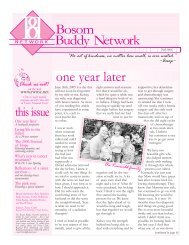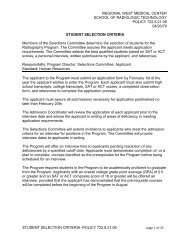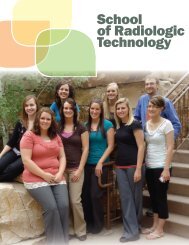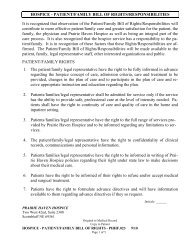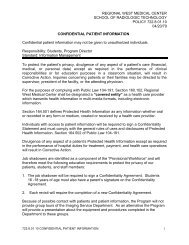Community Health Connection Update - Regional West Medical ...
Community Health Connection Update - Regional West Medical ...
Community Health Connection Update - Regional West Medical ...
Create successful ePaper yourself
Turn your PDF publications into a flip-book with our unique Google optimized e-Paper software.
Summer 2011“Exemplary” <strong>West</strong>ern Nebraska Trauma Care“Some calls seem to really stay with me. Some seem to tug on the heartstrings—this was one of them.”Carla Goranson, EMT-B, Kimball, Neb.We all know that life can change inthe blink of an eye. One momentCalifornia resident Marci Woodruffand her two teenagers weredriving down Nebraska’s I-80 ona sunny August morning in 2005.The next minute a car accident lefther sprawled across the passengerseat of their now-mangled car witha broken neck, and unable to moveher legs.Kimball EMT Carla Goransonwas the first responder to reachWoodruff. “I could tell in the first few seconds that Marciwas paralyzed,” says Goranson. “Actually I knew whenI looked in her kids’ eyes that something was terriblywrong.” Air Link medical helicopter soon arrived fromScottsbluff, landed on a now-closed I-80, and flew Woodruffto <strong>Regional</strong> <strong>West</strong> <strong>Medical</strong> Center in Scottsbluff.Because her husband Chuck worked for UPS, a UPS employeein Scottsbluff picked Rachel and Tyler WoodruffMarci Woodruff, shortly after the car accident thatleft her partially paralyzed.up at the Kimball hospital after theywere released and took them to theirmother at <strong>Regional</strong> <strong>West</strong>. They alsomade arrangements to fly Chuck toNebraska. Says Goranson, “Everyoneshowed the family such compassion—their hearts hurt for them.”After CT scans were done at <strong>Regional</strong><strong>West</strong>, surgeons determined that the diagnosiswas cervical 5 to cervical 7 vertebralfracture, with incomplete spinalcord injury and quadriplegia. A spinalcord injury at this level with quadriplegiausually results in the patient being wheelchair boundfor the rest of his or her life.“I know the Air Link crew quickly gave me steroids andthis is imperative after a spinal cord injury,” Woodruffsays. She also has high praise for <strong>Regional</strong> <strong>West</strong> <strong>Medical</strong>Center social worker Shelley (Fales) Thomas and the ICUstaff. “Whether it was tending my kids while I had surgery,dealing with insurance, or arranging for my transferContinued...
LEFT: The Woodruff’s vehicle after the accident.RIGHT: Marci Woodruff and her family today.From left: Rachel, Marci, Chuck, and Tyler Woodruff.Continued from Page 1...by Learjet, Shelley was a constant help,” says Woodruff. “As an RN myself, I know theICU staff was amazing. ICU nursing is extremely hard work, and they were exemplary!”After returning home to California, Woodruff spent two months recovering at theUniversity of California-Davis (UCD) <strong>Medical</strong> Center, where she was given an eightpercent chance of walking again. After being discharged from UCD in November,the hard work of in-home physical and occupational therapy began. By Christmas,Woodruff was covering short distances with a walker, and has since progressed towalking with a cane. “I’m profoundly grateful, and know that my initial care in Nebraskaand first hours and days of intervention played into my recovery,” she says.Five years later, life is good. “I’m now more appreciative of the little things—likewarm soapy showers and the laughter of family and friends,” Woodruff says. “Godused something catastrophic to let me see what matters most.”Woodruff still keeps in touch with Goranson and Thomas through email andFacebook. She says her experience in western Nebraska reinforces her belief thatwe are called to assist those in our path who need help, “Life is about seeing theblessings in the midst of pain, and learning to be thankful despite circumstances,”she explains.As an RN myself, I know the ICUstaff was amazing. ICU nursing isextremely hard work, and theywere exemplary!Marci Woodruff“I think, as a healthy person, you just kind of take it for granted that you’ll be ableto do those things you love,” Woodruff says. “For me it was things like gardening,walking my dog, working as a labor and delivery nurse. It’s a real shock when thosethings are removed in an instant. You grieve, you cope, you try to find meaning init.” The family now lives in Texas and Woodruff says she enjoys exercising in theirswimming pool with the family dogs, and gives back to others by mentoring prisonersthrough prison ministry. She even drives using a special vehicle adaptation, andsays that being behind the wheel again is “incredible.”Future plans? Definitely more travel with husband Chuck, says Woodruff. “Wehope to return to Nebraska some day—maybe even to mile marker 30!”“I’m just thankful to be alive.”
Gordon ProvidersCommitted to Hometown CareWhile 20 percent of Americans live in rural locales, accordingto a study published in the Journal of the American <strong>Medical</strong>Association, only nine percent of the nation’s physicians practicein rural areas.progressiveness. “Good things are happening at the hospital interms of adding new outreach physicians and new equipment likethe new CT scanner,” he says. “It all adds up to make everythingrun more smoothly and effectively.”Thanks to increased recruitment efforts in the past few years,lack of health care providers has not been an issue at one ofNebraska’s more ruralhospitals. Gordon MemorialHospital currently has twophysicians, one advancedpractice RN (APRN), andtwo physician assistants, andis in the process of recruitingone more family practicephysician.Gordon providers include:• Christopher Costa, MD;• Tony VanBang, MD;• Cassie Banks, APRN;• Lety Costa, PA-C, APRN;• Ronda Larson, PA-C.“When you don’t feel well,driving a long distance to seek care is the last thing you wantto do,” says Gordon Memorial Hospital CEO Jim LeBrun. “Byoffering quality providers to keep as much health care local aspossible, our patients definitely benefit.”Pictured front L to R: Lety Costa, PA-C, APRN; Cassie Banks, NP-C.Back row L to R: Christopher Costa, MD; Ronda Larson, PA-C; Antony Van Bang, MD.As two of the area’s newest health care providers, Dr. Costa, afamily practice physician, says that he and his wife Lety, a physicianassistant, enjoy the advantages afforded by a smaller hospital andcommunity. “We’ve lived in Gordon for close to two years and likethe community a lot—we’ve found everyone to be so welcomingand friendly,” he says. Dr. Costa also has praise for the hospital’sResidents in small communities like Gordon are often like abig family, says LeBrun. “When they see a medical provider,they want to see an individualwho has the same warmth,compassion, and friendlinessthat they find elsewhere intown,” he says. “That’s what wehave in Gordon, and that’s whatattracted our providers.”Physician specialists who travelto Gordon on a regular basis areanother way of keeping health carelocal. LeBrun cites the example ofScottsbluff Orthopaedic surgeonsAnthony Sanchez, MD, andGregory Harbach, MD, who nowregularly travel to Gordon to seepatients and perform surgery. Bydoing so, Gordon residents canreceive Orthopaedic care as well asfollow-up physical therapy in their own community.“We can never lose sight of the fact that our business is to takecare of people. With this partnership, our patients and thecommunity both benefit,” says LeBrun. “Keeping health careclose to home is vital to maintaining the future health of ruralpanhandle hospitals.”CONNECTION
The Panhandle’s EmergencyRadio System Helps Save Lives…Maybe Even YoursImagine this nightmare scenario with life and death consequences. A tornado hasleveled several blocks of a small western Nebraska community. When the first ambulancecrew reaches the scene, they determine that more help is needed to transportvictims. When the paramedic presses his radio call button to call for help…there is noservice. The outdated system has failed to keep up with demand during the disasterand the emergency radios are useless.“Quality, seamless communications fordaily medical emergencies, as well asdisaster situations, are essential for thecoordination of treatment to the sick andinjured. This is a remarkable project thatwill allow the connection with all out-ofhospitalemergency care providers inRegion 4 with local and regional hospitalsfor medical control.The future connection with the statewideinteroperable radio system will onlyenhance this delivery of service evenmore. <strong>Regional</strong> partnerships such as theone here in the panhandle definitely helpmake Nebraska a great place to live.”— Nebraska Lt. GovernorRick SheehyReliable radio contact can be crucial, especially when emergencies occur in rural areas.Now imagine if one of the victims wasyou or someone you love.Why does western Nebraskaneed new emergency radios?The panhandle’s current emergency radio systemhas served the region well since 1994. The radiosare, however, approaching the end of their usablelife and will become obsolete on January 1, 2013when a new federal regulation takes effect. At thattime, the Federal Communications Commission(FCC) requires regional hospitals and Emergency<strong>Medical</strong> Services to complete a conversion upgradefrom wide band to narrow band radio channels,with more radio frequencies available as a result.The current radios serving western Nebraska willnot work on narrow band.<strong>Health</strong> care providers and hospitals throughoutwestern Nebraska are teaming up to raise fundsto equip 16 panhandle counties with the lifesavingemergency radios and upgrade the communicationsystem. “We are passionate about our efforts inupgrading these emergency radios that are criticalto quality patient care and saving lives throughoutwestern Nebraska,” says Shelley Knutson, <strong>Regional</strong><strong>West</strong> Foundation Executive Director.Who is impacted?With over 100,000 plus residents spreadout over 18,500 miles of the panhandle,aevery second counts when someone is sickor injured and needs help. In 2010, Emergency<strong>Medical</strong> Services in Region 4 responded to over9,000 requests for medical assistance.
As owner of Valley Ambulance Services, Inc. and Mayor of Scottsbluff, RandyMeininger, NREMT-P, ASM, knows firsthand how beneficial the emergency radioservice is to panhandle residents. “When my uncle was trapped in a grain bin andtime was running out, it was so reassuring to be able to radio for additional helpand maintain communications with the hospital and physicians in a life-savingeffort,” he says. “<strong>West</strong>ern Nebraska allows us to have a quality of life we haveall come to love. Being raised on a farm and choosing to become a paramedic, Iknow many of the challenges that face us on a daily basis. This emergency radiosystem upgrade is essential in providing lifesaving treatment and transportationto the sick and injured.”Who can help?According to Knutson, the new federally-mandated radio system will ensurereliable, seamless communication between ground, air, and local/regionalhospitals during medical and trauma emergencies. “We are asking panhandleresidents to join our collaborative effort in donating to the <strong>West</strong>ern NebraskaEmergency Care <strong>Connection</strong> Campaign to help save time, money, and lives,” she says.“The radio system upgrade will provide western Nebraska’s dedicatedemergency medical responders with the communication equipment needed forlife-saving treatment and transportation,” says Meininger.Emergency Care<strong>Connection</strong>Box Butte General Hospital | AllianceChase County <strong>Community</strong> Hospital | ImperialChadron <strong>Community</strong> Hospital | ChadronGarden County <strong>Health</strong> Services | OshkoshGordon <strong>Health</strong> Services | GordonKimball <strong>Health</strong> Services | KimballMemorial <strong>Health</strong> Center | SidneyMorrill County <strong>Community</strong> Hospital | BridgeportOgallala <strong>Community</strong> Hospital | OgallalaPerkins County <strong>Health</strong> Services | Grant<strong>Regional</strong> <strong>West</strong> <strong>Medical</strong> Center | ScottsbluffAll donations are welcome and can be sent directly to your local hospital, incare of the <strong>West</strong>ern Nebraska Emergency Care <strong>Connection</strong> Campaign.For more information about this regional fundraising campaign, pleasecall <strong>Regional</strong> <strong>West</strong> Foundation, 308.630.1485.CONNECTION
Panhandle-WideNeeds Assessment Survey“Hello, I’m with Sigma Group in Lincoln. We are conducting a community health needs assessmentin your county to help area hospitals and health services providers improve the qualityand availability of services in the panhandle area. We need to get your opinion on the healthservices available to you, and of the health needs of people in your area.”If you were a member of one of the 1,004 western Nebraskahouseholds that were asked to answer the above phone surveylast fall, your input may help change the way that health care isdelivered in the panhandle.The survey was initiated by <strong>Regional</strong> <strong>West</strong> <strong>Medical</strong> Center, butresults were shared and discussed with panhandle hospital CEOsin an ongoing effort to provide the region’s residents with acollaborative network of care. Panhandle hospitals are committedto increasing the availability of local health care while providing themeans to move patients to higher levels of care when necessary.Survey results showed:1. Overall, panhandle residents rate their health status close tothe national average. In other words, when asked health statusquestions, their answers were statistically equal to those insurveys of people who live in other parts of the United States,including those in urban areas.2. When asked about conditions not currently being treated, justsix percent of respondents reported being concerned aboutan untreated health condition of someone in their household.Their reasons for not accessing care related primarily to costand accessibility.According to survey respondents, the top reasons for outmigration (traveling elsewhere for care) were:▪ Physician referral = 64 percent.▪ Perception of a lack of local service = 65 percent.▪ Perception of better care = 64 percent.Stuart Fulks, <strong>Regional</strong> <strong>West</strong> Vice President of Marketing andStrategic Planning, said the survey’s message was clear. “One ofour key jobs going forward is to increase awareness of the level ofcare available right here in the panhandle,” he says. “For example,just 14 percent of survey respondents knew that Neurologyservices are available in western Nebraska. Traveling out of theregion to see a physician, especially when you don’t feel well, issomething we hope people can avoid in the future.”Fulks adds that improving the continuity of care in outreachclinics throughout the panhandle is also a major focus of areahospitals, which was reflected in survey questions. “Seeking localcare first is always the best option,” he says. “<strong>West</strong>ern Nebraskais fortunate to have quality local health care providers, as well asthe ability to provide a seamless continuum of treatment shouldpatients need to be referred to a higher level of care.”3. When asked if they had left the panhandle for medical carewithin the last five years, 56 percent of respondents said yes. Themajority of people who went elsewhere sought Orthopaedic,Cardiology, Neurology, Oncology, or Dermatology care.CONNECTION
TAKE THE HELM AT TWO COMMUNITYHEALTH CONNECTION HOSPITALSJim Hansel, CEOGarden County <strong>Health</strong> ServicesAlthough he is new to GardenCounty <strong>Health</strong> Services (GCHS),CEO Jim Hansel is no strangerto western Nebraska.Prior to his new position, Hansel,an Oshkosh native, served as Memorial<strong>Health</strong> Center Chief OperationsOfficer, Chief HumanResources Officer, and ExecutiveDirector of the <strong>Health</strong> CenterFoundation in Sidney for fouryears. Before that, he worked athealth care facilities in Williston,N.D. and Albion, Neb.Hansel says that partnering with other area hospitals is “simplythe right thing to do for our patients.”“Through our continuing partnerships, we experience many benefits.We gain cost control on medical supply purchases throughlarger purchasing group alliances. We get expanded Human Resourcesupport and additional educational opportunities for staffand leadership. We also receive extended marketing and recruitmentsupport. Larger medical care centers need and want facilitieslike GCHS to succeed because it serves the greater good. Itserves the patient where their care is most likely to be successful…at home,” he explains.Hansel agrees with the basic <strong>Community</strong> <strong>Health</strong> <strong>Connection</strong> philosophythat seeking local health care first is optimal for patients.Although collaboration among area hospitals is vital, he says thatevery successful health care system has its own individual identity.“For a health care system to succeed, it must create its own uniquepersonality within the larger frame of joint partnership and support.It takes a community-wide effort to bring in the resourcesneeded to serve the Garden County area.”Kenneth Hunter, CEOKimball <strong>Health</strong> ServicesHaving called Kimball homefor the last five years, newKimball <strong>Health</strong> ServicesCEO Kenneth Hunter is alreadyfamiliar with the community’shealth care needs.He has a clear vision how the<strong>Community</strong> <strong>Health</strong> <strong>Connection</strong>(CHC) partnership translatesinto patient benefits.“Kimball <strong>Health</strong> Services andthe patients we serve benefitvery directly from the CHCpartnership,” he says. “Fromhelping eliminate duplication of services for our patients to trainingfor our staffs to collaboration among the CEOs, we all benefitfrom each other’s expertise and experience.”Prior to his January appointment as Kimball <strong>Health</strong> ServicesCEO, Hunter served as the hospital’s Director of Nursing for fiveyears. He has also worked in health care facilities in Chattanooga,Tenn., Greenville, Miss., Vicksburg, Miss., and Tucson, Ariz.Hunter says that he’s looking forward to using his background innursing, health care management, and marketing to build on thework started by former CEO Julie Schnell.Hunter cites continued physician recruitment, relations, and retentionefforts as an “utmost priority” for the hospital. “I want to continueattracting more visiting specialists and increase the numberof surgeries we do,” he says. Currently, visiting specialists providecare in Dermatology; Surgery; Cardiology; and Ophthalmology.When summing up the CHC philosophy shared by panhandlehospitals, Hunter says, “Simply opening up the lines of communicationamong our member hospitals and sharing resources helpsassure that our patients get the best care possible.”CONNECTION
Here is What’s Happeningat your <strong>Community</strong> <strong>Health</strong> <strong>Connection</strong> locationBox Butte General Hospital, AllianceTeam Strategies and Tools to Enhance Performance and Patient Safety (TeamSTEPPS) is part of the patient careculture at Box Butte General Hospital (BBGH), so much so that five BBGH Master Trainers were asked to bepresenters at a “Train the Trainer” conference recently held in LaVista, Neb. Computer Education CoordinatorTammy Suit and Nurse Educator JaeAnn Bradt presented a module titled “Mutual Support.” Special ServicesDirector Mary Mockerman, <strong>Medical</strong> Imaging Manager Carolyn Anglesey and Clinical Nurse Manager CarolynJones provided skits to highlight mutual support scenarios.Chadron <strong>Community</strong> Hospital, ChadronThe second annual “Show the Light in Your Heart” fundraising event for cancer was held April 15 and raiseda record-setting $13,700 in just one night. With all donations, a final total of $50,000 is expected. Event plannerswere Jodi Danner, Tricia Thayer, and Brenda Rhembrandt. Proceeds raised go to cancer survivors in BoxButte, Dawes, Sheridan, and Sioux counties to help with medical and non-medical expenses.CONNECTIONThe <strong>Community</strong> <strong>Health</strong> <strong>Connection</strong><strong>Update</strong> is a joint effort of eight westernNebraska hospitals: Box Butte GeneralHospital, Chadron <strong>Community</strong> Hospital,Garden County <strong>Health</strong> Services, Gordon<strong>Health</strong> Services, Kimball <strong>Health</strong>Services, Memorial <strong>Health</strong> Center,Morrill County <strong>Community</strong> Hospital,and <strong>Regional</strong> <strong>West</strong> <strong>Medical</strong> Center.Teresa Clark Writer/Editor308.630.2667 | ttclark@charter.netGarden County <strong>Health</strong> Services, OshkoshSeveral Nebraska counties are watching and learning from the Paramedic model that Garden County<strong>Health</strong> Services (GCHS) is spearheading. GCHS utilizes both a trained volunteer ambulance squad andtrained Paramedics to assist in emergency calls and requests. Members of the volunteer squad put in countlesshours of training. Paramedics are trained professionals who can continue the care into the facility andassist in the Emergency Department within the guidelines and parameters established by licensure andstatute.Gordon Memorial <strong>Health</strong> Services, GordonAfter two years without mammography services, and with the generous donation of equipment from BoxButte General Hospital in Alliance, Gordon Memorial <strong>Health</strong> Services is please to announce that as of March15 the hospital is now able to do mammograms once again. With the addition of another Radiology Tech,they now offer full time ultrasound services including OB/GYN, vascular, and examining extremities.Kimball <strong>Health</strong> Services, KimballA new 16-slice computerized axial tomography (CAT) scanner is one of several new ways Kimball <strong>Health</strong>Services is using technology to benefit its patients. The new scanner takes a series of X-ray images at differentangles to create cross-sectional, two-and three-dimensional images of bones and soft tissues. Theseimages help detect conditions such as cancer, vascular diseases, and hemorrhaging in the brain.Memorial <strong>Health</strong> Center, SidneyMemorial <strong>Health</strong> Center (MHC) is pleased to announce that April 27 marked the opening of the new MHCDaryl Conger Rehabilitation Center. This new space is almost double the size of the previous rehabilitationarea. This renovation was made possible by the vision and generous donations from those in the Sidney community.MHC would also like to welcome Robert Graves, MD, Urologist, to the MHC Family. If you wouldlike more information regarding the services available from MHC, please contact the hospital at 308.254.5825or go to www.memorialhealthcenter.org.Morrill county community hospital, bridgeportMorrill County <strong>Community</strong>Hospital is in the process of building a new clinic that will attach to the hospital.This connection will make it very convenient for patients who have clinic visits to obtain hospital servicesfrom lab, X-ray, CT, or other inpatient or outpatient areas. There will also be a section of the clinic devotedto visiting specialists who come to Bridgeport. Anticipated completion is late September or early October ofthis year.<strong>Regional</strong> <strong>West</strong> <strong>Medical</strong> Center, ScottsbluffThe Cancer Treatment Center at <strong>Regional</strong> <strong>West</strong> has been awarded the Outstanding Achievement Awardfrom the American College of Surgeons Commission on Cancer. The Cancer Treatment Center is oneof 90 cancer programs nationwide to receive the award and is the only cancer program in Nebraska toreceive the award each time it has been presented.CONNECTION



